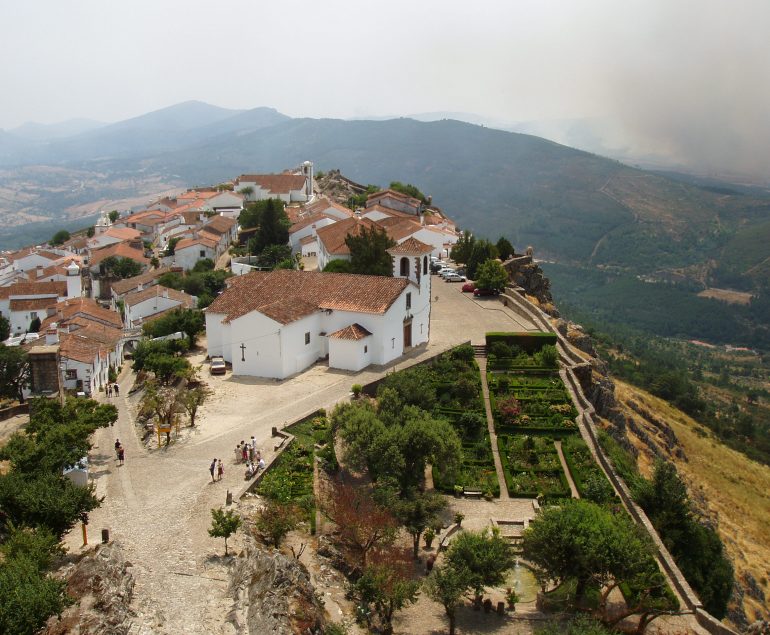“In Freixo de Espada-à-Cinta, history isn’t just preserved in stone — it lingers in the streets, in the river breeze, in the legends whispered at dusk.”
Arrival in the Borderlands
The road to Freixo de Espada-à-Cinta winds through one of Portugal’s most remote corners, the Douro Superior. Vineyards give way to rugged cliffs, and the river carves a deep, silent path through the land. As we drove closer, the landscape felt timeless — wide skies, dry hills dotted with olive groves, and the occasional stone village pressed against the earth.
At last, the town came into view. Whitewashed houses climbed the hillside, and above them rose the keep tower of the castle, square and stubborn, as if still guarding the frontier centuries after its wars were fought. To see the castle from a distance is to feel its purpose: a sentinel watching the river, the valley, and the border with Spain.
The History of a Fortress
Freixo de Espada-à-Cinta’s castle dates back to the 12th or early 13th century, part of a line of fortifications built to protect Portugal’s eastern frontier. It was under King Dinis (1279–1325) that the fortress gained its shape and stature. This was a time when the Douro was not a peaceful wine region but a contested frontier. Castilian incursions were real threats, and each tower along the river served as both a lookout and a statement: this land is ours.
The castle was small compared to others in the region, but its position made it vital. The keep — one of the tallest medieval towers in Trás-os-Montes — dominated the landscape. Around it stretched curtain walls that once enclosed the medieval town. Though most of those walls have vanished, the keep still stands, a relic of strength in stone.
“The keep of Freixo de Espada-à-Cinta rises not as a ruin but as a memory carved against the sky.”
Over the centuries, the castle’s military role diminished. By the 16th century, Portugal’s eastern frontier was more secure, and attention shifted from war to trade, from defence to the cultural flowering of the Manueline age. The town remained proud of its fortress, but the stones gradually fell silent.
Walking the Town
We entered Freixo de Espada-à-Cinta through narrow, cobbled streets that seemed to coil around the hill. The first thing that caught our eye wasn’t the castle but the windows — delicate Manueline carvings framing small balconies and doorways. Few towns in Portugal preserve so many of these flourishes. They reminded us that this was once a place of wealth and importance, connected to both the river and the crown.
Every corner seemed to whisper something. Old men sat in the shade of orange trees, discussing football. A woman hung laundry from a balcony painted with azulejos. The town felt unhurried, proud of its isolation, shaped by both the Douro’s bounty and its frontier hardships.
Freixo is also a place of stories. Its very name, “Ash tree with a sword at its belt,” evokes legend. Locals will tell you of the knight who, before battle, tied his sword to an ash tree — a symbol of courage that gave the town its unforgettable name.
Exploring the Castle
Reaching the keep required a short climb through alleys that opened suddenly into a square. There it was: the tower of menagem, rising tall and defiant. Its granite walls were plain, almost severe, yet there was beauty in their simplicity.
We climbed inside, stone steps spiralling upward, cool and damp from centuries of silence. From the top, the view stunned us. To the east lay Spain, its hills brown and dry. To the west stretched the undulating folds of Portugal’s interior. And below, the Douro shimmered like a silver blade.
“From the keep of Freixo, the Douro is not just a river — it is a frontier, a story, a line between worlds.”
There isn’t much left of the curtain walls, but you can trace their outline through the town. Some stones were absorbed into houses, others scattered in gardens. What remains is a sense of how the town once huddled under the castle’s protection.
Legends and the Ash Tree
The name of Freixo de Espada-à-Cinta sets it apart from every other Portuguese town. It is both poetic and martial, a blending of nature and steel. According to legend, a knight tied his sword to an ash tree before entering combat. Victorious, he returned and planted both memory and myth into the town’s identity.
Whether or not the story is true hardly matters. It reflects something essential about the place—that life here has always been about resilience, courage, and survival in the face of frontier uncertainty. Standing by the keep, with the wind brushing the stones, we could almost picture the knight’s gesture, centuries folded into a single name.
What to Do and See Nearby
Freixo de Espada-à-Cinta may feel remote, but it offers richness for those who linger.
The Douro River—From here, the river is wilder and less tamed than in the wine country around Peso da Régua. Cruises depart to explore the canyons, where cliffs rise dramatically on either side.
Miranda do Douro—To the north, this border town has its own imposing cathedral and a unique language, Mirandês, still spoken by locals.
Mogadouro – Another medieval fortress town, worth visiting to understand how these castles once formed a chain of defence.
The Douro International Natural Park – Stretching along the border, this protected area is home to golden eagles, vultures, and some of the most dramatic landscapes in Portugal.
Wine and Olive Oil—The Douro Superior produces bold wines and exceptional olive oil. Small producers welcome visitors with tastings that feel personal and authentic.
We spent the evening wandering through olive groves, the sun sinking behind the hills, painting the sky with oranges and purples. In the quiet, the keep tower of Freixo stood silhouetted—a reminder that even the smallest castles can carry the weight of centuries.
How to Get There
Reaching Freixo de Espada-à-Cinta is part of the adventure. This is one of Portugal’s most secluded towns, tucked into the Douro Superior near the Spanish border.
-
By Car – The easiest and most flexible option. From Porto, it’s about a 3.5 to 4-hour drive (around 250 km) via the A4 motorway towards Vila Real, then branching east through Torre de Moncorvo. From Bragança, expect a 2.5-hour drive. The roads become more winding as you approach the Douro, but the scenery is spectacular.
-
By Train/Bus – There’s no direct train to Freixo. The closest rail connections are to Pocinho (on the scenic Douro line), after which you’d need a bus or taxi. Regional buses run from Bragança, Torre de Moncorvo, and Miranda do Douro, though they are infrequent.
-
By River—In summer, some Douro cruises include stops or excursions in the Freixo area, though they are less common than trips to Peso da Régua or Pinhão. Private boat tours are another option if you want to explore the wild canyons of the Douro International Natural Park.
Because of its remoteness, most travellers visit by car, often combining it with a road trip through the Douro International Natural Park and other fortress towns like Mogadouro and Miranda do Douro.
Closing Reflection
Freixo de Espada-à-Cinta isn’t a place that overwhelms with grandeur. Instead, it captivates with atmosphere. The keep may be modest compared to Sintra’s palaces or Guimarães’ battlements, but its solitude and setting make it unforgettable. Here, on the edge of Portugal, history breathes softly but persistently.
“Traveling to Freixo is less about ticking off monuments and more about listening — to the wind in the tower, to the river below, to the stories of those who came before.”
When we finally left, driving once more into the vastness of the Douro Superior, we carried with us not just images of stone and legend but a sense of Portugal’s resilience, written in towers, whispered in myths, and guarded by the silent sentinel of Freixo.






